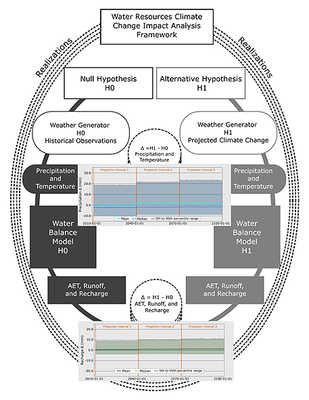Background
Climate is the weather of a place averaged over a period of time; a three-decade average of weather measures, called Climate Normals, is frequently used for climate description. Weather, in contrast to climate, includes all daily events that occur in the atmosphere and it varies across much shorter intervals, like minutes to weeks. Across the planet, average temperatures are expected to increase by 1.5 °C between 2030 and 2052, relative to pre-industrial levels, and corresponding impacts to natural and human systems are expected as a result. Changing climatic conditions, or changing average weather, will impact future water resources availability at the watershed scale. Surface runoff, or stream flow generation, and aquifer recharge are the physical processes of interest for water resources considerations because they provide sources and stores of water available for management and consumption.
Analysis of watershed water resources availability starts with weather parameters as a main input or forcing mechanism to a water budget computation. Precipitation and potential evapotranspiration are the main drivers; precipitation is a weather event, and evapotranspiration is largely determined by weather parameters, especially temperature. Precipitation adds water to the water budget calculation and evapotranspiration subtracts water prior to runoff and recharge. Because of the complex interplay of precipitation and evapotranspiration at the daily and monthly time scale, identification of projected climate trends is not sufficient to directly interpolate consequent trends in water resources availability.
Approach
 Figure 1: Climate change, relative impact analysis framework for watershed-scale water resources. The purpose of this new framework is to provide a risk assessment methodology for water resources managers that explicitly addresses and incorporates the uncertainty inherent in simulating future conditions.
Figure 1: Climate change, relative impact analysis framework for watershed-scale water resources. The purpose of this new framework is to provide a risk assessment methodology for water resources managers that explicitly addresses and incorporates the uncertainty inherent in simulating future conditions. A framework, or algorithm, for assessment of relative risk to watershed-scale water resources from systemic changes was created (Figure 1). It is composed of two experiments, or pathways, within a Monte Carlo structure and provides quantification of prediction uncertainty. One simulation pathway is the “no change,” or null hypothesis, experiment, and the other provides simulation of the hypothesized system change. Each pathway uses a stochastic weather generator and a deterministic water balance model. For climate change impact analysis, the framework is calibrated so that the differences between 30-year average precipitation and temperature pathway values reproduce climate trends. This simulated weather provides forcing to identical water balance models to isolate impacts from climate trends. Probabilistic time histories of differences in water balance components between pathways are the primary results and provide likelihood per magnitude change to water resources availability.
Accomplishments
The framework (Figure 1) was successfully formulated and implemented for a case study watershed in a semi-arid region of Texas. Projected climate trends identified for the site are a 3°C increase in average temperature and a corresponding increase in potential evapotranspiration, no significant change in average annual precipitation, and a consistent semi-arid classification from 2011-2100. Despite the identified climate trends, this framework implementation predicts no significant change, on average, to actual evapotranspiration, runoff, or recharge from 2011-2100 because average annual precipitation is relatively constant and the site water budget is supply-limited under existing conditions.
